The ARM vs x86 Wars Have Begun: In-Depth Power Analysis of Atom, Krait & Cortex A15
by Anand Lal Shimpi on January 4, 2013 7:32 AM EST- Posted in
- Tablets
- Intel
- Samsung
- Arm
- Cortex A15
- Smartphones
- Mobile
- SoCs
Cortex A15: Kraken
While SunSpider wasn't a great performance target for Exynos 5250, Kraken is a different story entirely. The Cortex A15s complete the task significantly quicker than the competition, and as a result achieve competitive energy usage although at significantly higher peak power consumption.
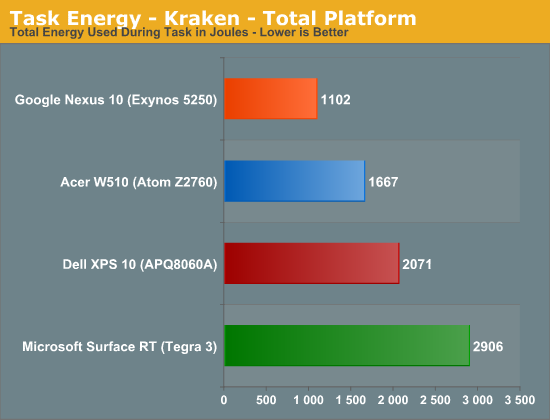
Despite the high peak power consumption of the Nexus 10 and its Cortex A15s, total energy usage is the lowest out of any of the contenders here since the Exynos 5250 is able to complete the benchmark so quickly. Intel is up next, followed by Qualcomm.
Once again we're seeing peak CPU power usage of ~3W, compared to < 1.5W for the competition. The performance advantage is enough to justify the added power, however in devices that simply can't dissipate this much heat (e.g. smartphones) I wonder what will happen.

Isolate the CPU cores themselves and the race is much closer, this time with Qualcomm taking the lead.
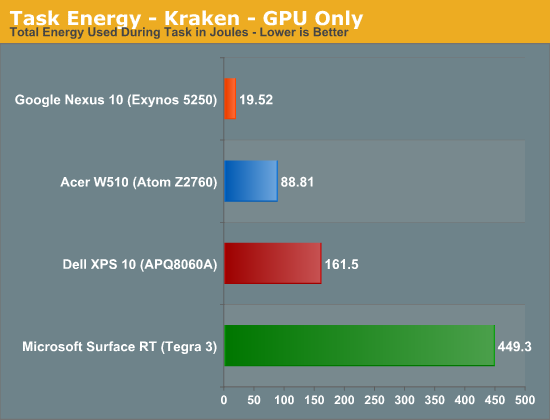
When mostly idle, the Mali-T604 on Samsung's 32nm LP (HK+MG) process barely sips power.
Kraken - Max, Avg, Min Power
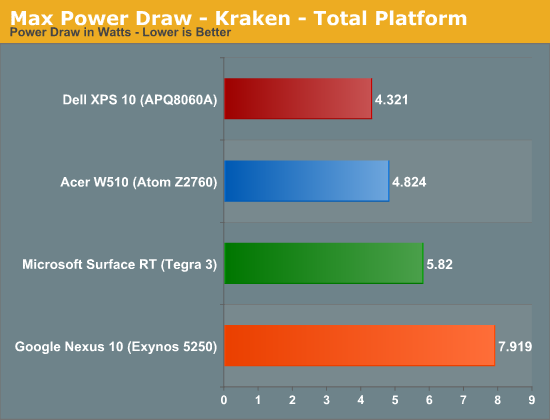
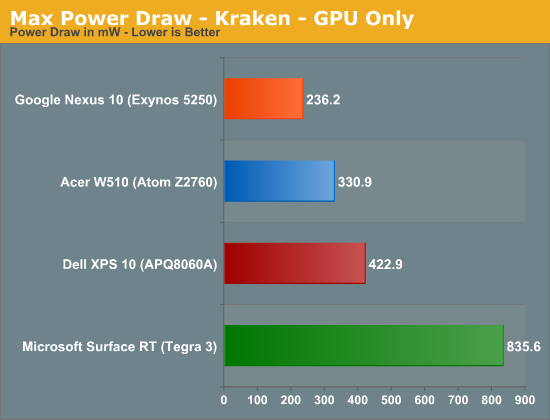
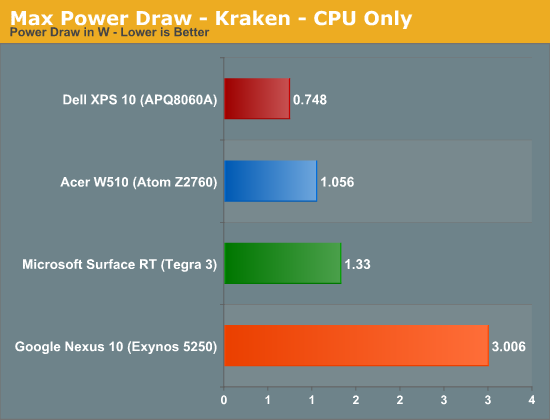
Average Power Draw
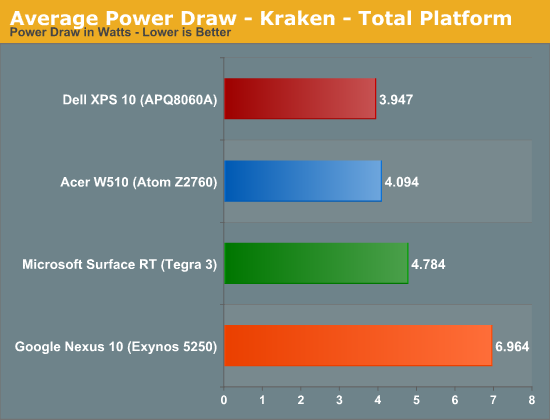
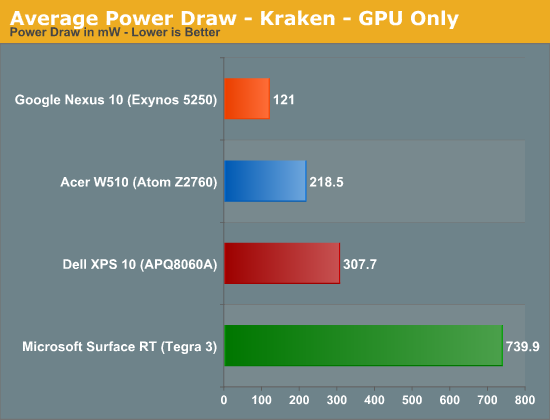

Minimum Power Draw

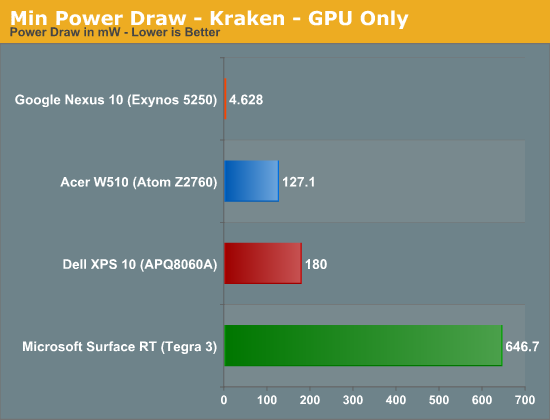
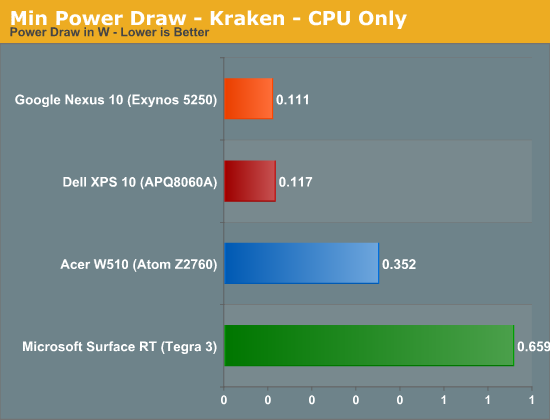


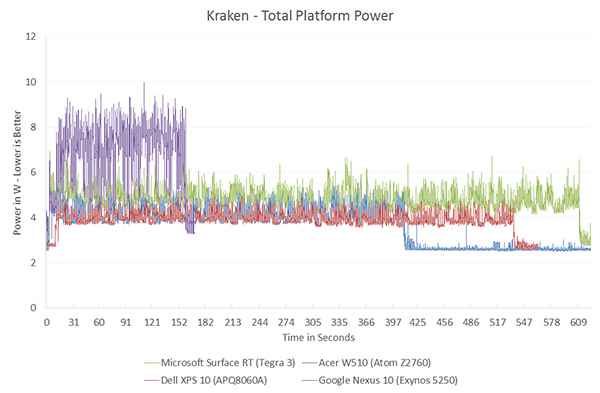
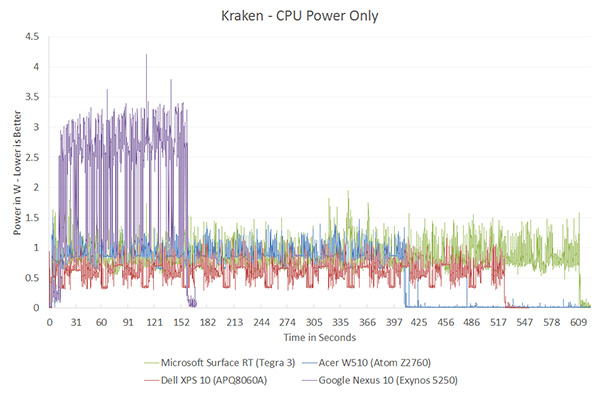
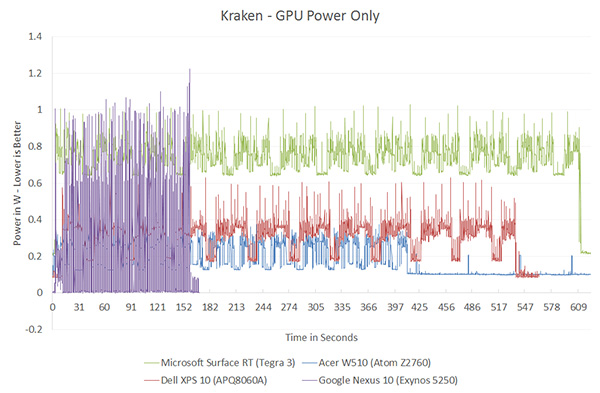








140 Comments
View All Comments
some_guy - Saturday, January 5, 2013 - link
I was reading comments about how Intel can't compete on price because it will cannibalize profits from higher margin chips.My sense is that Intel will aggressively attempt to squash ARM just like cored AMD. I think they are aware of the imminent threat.
Cannibalizing their own profits from higher margin chips is inevitable and may be a better choice than being eaten alive by ARM.
(BTW I didn't read all 11 pages of comments, so sorry if this was already stated.)
nofumble62 - Saturday, January 5, 2013 - link
Intel current margin is >60% but its stock price didn't rise an inch.The concern is about architecture and future.
As long as they can get into mobile and get market share back, their stock price will spike.
So YES, they can and will drop the price to compete. Their cheap smartphones are already in store in India, China, and Europe.
Don't forget that there are plenty of companies doing well with much smaller margin.
mugiebahar - Saturday, January 5, 2013 - link
While theory will agree, it's not so easy. Simple illustration (only in smart phone tablets)Company 1 (ARM) - employes 1 person and works from home.
Company 2 (Intel) - employes 100 people and rents a warehouse.
Cost to run business 1 - ?
Cost to run business 2 - ???
ARM owns the market now (just for now is all I'm saying) - revenue per expenses = great
Intel is negligible - revenue to expenses = disaster (not that won't change, but the
money spent already over the years)
Company 1 has loyalty and legacy in this market.
Company 2 is HOPING it has loyalty and the it legacy support will matter in this market!
The article makes it seem that it's a one deal Intel will be in the marke and we just have to wait. But that's wrong. Right now we are having phone that can do everything we need at the moment. Yes it will get better but we don't need the leaps n bounds anymore @ a cost we really don't need to spend.
Also if Intel sells a core CPU SoC and it goes for 20-30 like ARM SoC. uneducated people will look at it as an insult that the desk top costs so much. And while its completely different levels of power average joe won't know, and humans are the worst critics correct? I stated before its not about intel not being able to make a chip. It's their company s structured so wrong for this market. You have to be small and agie. AMD would have a better shot at it, if they had the smarts.
some_guy - Sunday, January 6, 2013 - link
It could get ugly.Intel will not give up the high end ARM market without a fight because next stop is desktop market. And Intel may not succeed.
Apple is already majorly moving away from Intel which gives the lots of leverage.
This may be Intel's long twilight, and AMD's shorter twilight.
CuriousSoul - Saturday, January 5, 2013 - link
Without knowing the Frames Per Second, Games settings for 3D Game 1 how is is possible to compare all of the graphs in any sense other than maximum mW ?It's like saying a VW Golf is more frugal around a race track than a Ferrari !
One resistor could draw 1mW and another 1000mW but which is better at the actual 3D Game 1? (in this case they offer an identical experience).
Cold Fussion - Saturday, January 5, 2013 - link
Yea this was mentioned multiple times before, It doesn't do very much to alleviate the claims of Anand's Intel bias does it?jameskatt - Sunday, January 6, 2013 - link
The first problem for Intel is that every major ARM chip company develops their own ARM chips. Apple does it. Samsung does it, etc. This means that these companies will NOT buy third party CPU/GPUs for their ARM devices. By developing their own ARM chips, they cut out Intel as the middle man and Intel's profits. For low priced devices, it is crucial to do this since margins can be very low or in Apple's case, the need to make profit is very high. These companies will not be Intel customers for chips. Intel is locked out. This is why Texas Instruments got out of the ARM business.The second problem for Intel is that the ARM-chips have a huge ecosystem supporting it. Apple has their iOS software kingdom with over a million apps. Android has it hundreds of thousands of apps. These ecosystems have a heavy momentum of their own. Their number dwarfs the number of apps available to the Intel platform. Thus Intel has a difficult job convincing anyone to incorporate its CPUs in to devices which will automatically be incompatible for the existing ecosystems.
What Intel can do is to simply keep aggressively developing its own chips so that they can compete strongly with the ARM chips so that Intel can keep the ecosystem it currently has - laptops, desktops, mainframe and supercomputers.
Intel won't be able to compete on price. it has to make its own profits. It won't be able to compete at the bottom of the device market. But it certainly can keep and expand its own arena. Microsoft surface tablets are an example of an attempt to keep its own ecosystem.
omind - Monday, January 7, 2013 - link
James,Intel is not trying to sell IP to existing ARM chip companies (Samsung, Nvidia etc) but instead are creating complete SOCs, including GPU, Video en- and decoders and so on. They are positioning themselves as competitiors to SOC manufacturers not as suppliers.
Secondly, the Atoms already in the market (Medfield) can leverage the Android app ecosystem. This is accomplished by a version of Android's Dalvik adapted to the x86 ISA. I personally own a Medfield-powered Motorola Razr-i and I can say that every single app I downloaded from Google's play store does run without any problem whatsoever on it. Contrary to the popular belief, there is no ecosystem problem for the end user.
Best regards
mrdude - Wednesday, January 9, 2013 - link
I think his point is that today the big device makers are also have their own SoCs, thus locking Intel out from the beginning. The push towards vertical integration threatens Intel drastically. And unlike a Qualcomm, Intel currently has very little to offer that stands out from the rest of the competition in the tablet and smartphone space (I say tablet because the sales of x86 tablets has been really poor. Consumers don't value x86 compatibility on their tablet)Intel just can't compete on price. I know this gets brought up endlessly but it's something that's absolutely true. Intel operates on sky high margins and that's something that's impossible to do if you're only making SoCs for tablets and smartphones. If the high end is cannibalized at an accelerating rate going forward (and the figures I've read point to this) then Intel is going to be in big big trouble. There's just no way the company can maintain its sky high margins and even keep its own fabs (and R&D) by selling ~$20 SoCs. It's just not gonna' happen. Either Intel provides something that only they can offer and that's wanted by every device maker and consumer and warrants a higher price tag or they begin their slow march downhill.
wsw1982 - Friday, January 11, 2013 - link
Intel sell much more processors today than they were in 2010/2009, if they can maintain their own fabs then, I don't see the reason why they cannot now. The $20-$30 SOC is new market for Intel, not a replacement (at least in near feature). The additional market should be welcomed, right? It reminded me that back to 2008 when Intel first introduced the ATOM, a lot of genius started to cry that Intel opened the netbook market and sale chip at $30 and it would cannibalize the notebook market and hurt Intel's profit. But the years after are one of intel's fast growing age.As for the price? Why cannot Intel compete? doesn't it have enough revenue (PC&Server revenue is much more than 2010 and 2009) to even up the R&D? does it need to pay a bloody foundry fee to TSMC (who alone enjoy 40% margin)? does it have to pay a license fee to ARM? Doesn't it already spend a forturn on PR? Doesn't it already have the manufacture volume ? (50% in idle, anyway will be wasted, why don't produce something at least earn some money)
And I think Intel is never as competitive as now. It gaining it position in server market for the last few year, it's pc business has never such high market share, it's mobile chip start to crush ARM in any respect.
http://www.phonearena.com/news/Intel-Atom-powered-...
check this out, the smart phone lenovo K900 score more than 25000 in Antutu on a 1080P display, which not only crush snapdragon pro (4 krait) in Optimus G but also the newly release Samsung Exynos 5440 (2 A15) in Nexus 10